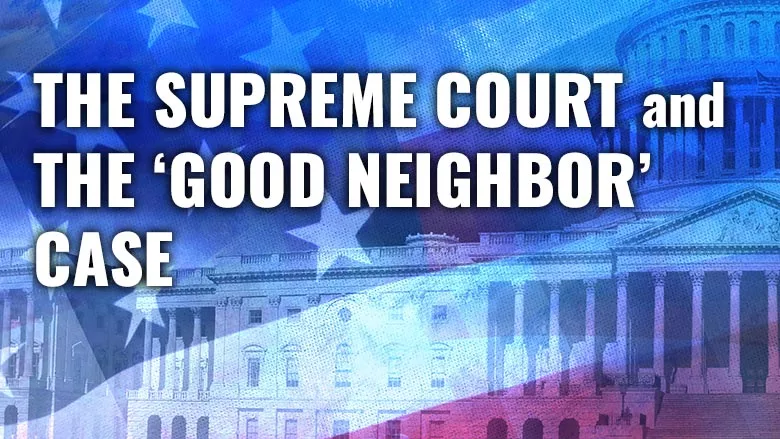Supreme Court Hears Arguments in ‘Good Neighbor’ Case
Justices skeptical about request to issue an ‘emergency stay’ of EPA plan

Source: Getty Images
Some states argued their case before the Supreme Court on Feb. 21, 2024, regarding the Environmental Protection Agency's (EPA's) “Good Neighbor Plan,” which requires power plants and other polluting industries located in upwind states like Ohio and Indiana to reduce emissions that create ground-level ozone, commonly known as smog, that flows to downwind states. The states called for the court to issue an “emergency stay” to the plan, a request the justices seemed reluctant to grant.
The Good Neighbor Plan secures significant reductions in ozone-forming emissions of nitrogen oxides (NOX) from power plants and industrial facilities in upwind states, said the EPA, which added that upwind states reducing industrial NOX will result in a reduction of their contributions to smog levels in downwind states.
In 2015, EPA revised the ozone “national ambient air quality standards” (NAAQS), and states were required to submit revised “state implementation plans” (SIP) by 2018 to comply with the new, more stringent standards.
However, 21 states submitted SIPs in which they proposed to take no action to revise their SIPs because they said existing controls were adequate, or that such revisions would not contribute significantly to nonattainment, or interfere with maintenance of existing federal ozone standards in other states.
As a result, EPA took two actions in 2023 to address states’ Good Neighbor obligations under the 2015 NAAQS. The first was in February 2023, when EPA disapproved the submissions by the 21 states. The second occurred on March 15, 2023, when the EPA issued a “federal implementation plan” (FIP) — the Good Neighbor Plan — covering the 21 states that refused to revise their SIPs, as well as two additional states that had not submitted any revisions to their plans.
As of Sept. 21, 2023, the Good Neighbor Plan’s “Group 3” ozone-season NOX control program for power plants is being implemented in Illinois, Indiana, Maryland, Michigan, New Jersey, New York, Ohio, Pennsylvania, Virginia, and Wisconsin.
However, a stay issued by the U.S. Court of Appeals for the District of Columbia Circuit prevents EPA from pursuing “SIP disapproval action(s)” for Alabama, Arkansas, Kentucky, Louisiana, Minnesota, Mississippi, Missouri, Nevada, Oklahoma, Texas, Utah, and West Virginia. Despite the stay, states opposed to revising their SIPs appealed to the Supreme Court to issue an “emergency stay”.
Justices noted that the states opposed to revising their SIPs already have a stay issued by the U.S. Court of Appeals for the D.C. Circuit, but that court has not yet been fully briefed.
“Why did you come to us when you’re already before the D.C. Circuit? Why didn’t you ask them (the D.C. Circuit) to move quickly?” a justice asked one of two lawyers representing the states opposed to revising their SIPs.
“We are seeking a stay (from the Supreme Court) because of the irreparable harms” to Ohio’s electric grid allegedly being caused by the Good Neighbor Plan, said Mathura J. Sridharan, Deputy Solicitor General for Columbus, Ohio. Sridharan added the plan is an “unlawful federal rule,” and the EPA failed to consider the impact states that do not comply with the plan would have on states that do.
“Irreparable harm is insufficient” to request the Supreme Court to be the venue of first choice, a justice said.
The arguments took another track with Catherine E. Stetson, who represented the states opposed to revising their SIPs. She said the program to reduce emissions in the upwind states is not producing cost-effective reductions in smog in the downwind states.
“It’s not a question about whether EPA can regulate emissions, but if EPA can do that at a reasonable cost.”
– Catherine E. Stetson
“It’s not a question about whether EPA can regulate emissions, but if EPA can do that at a reasonable cost,” Stetson said. However, the situation of federal control changes “if states can do that more cheaply,” she noted.
The attorney representing the EPA addressed the issue of smog reductions in the downwind states not meeting expectations.
“It’s true, the reductions of emissions is not meeting anticipated levels because only 11 states are participating (in the Good Neighbor Plan), rather than 23,” said Malcolm L. Stewart, Deputy Solicitor General, Department of Justice.
Justices asked Stewart if the EPA considered comments critical of the Good Neighbor Plan when it was a proposed rule, and if EPA will consider reviewing the regulation once litigation is complete.
“It wouldn’t make sense for EPA to do a ground-up inquiry (of the plan), but following a court ruling, a new configuration of states (to participate in the plan) might be considered,” Stewart said.
Justices also raised the claim of “irreparable harm” the plan might be doing to states’ electric grids, which has been cited as a reason for the court to issue an emergency stay.
“Just showing irreparable harm is not enough when there is irreparable harm on the other side” that is being caused by the amount of emissions flowing from upwind states to downwind states, Stewart said. “The downwind states will suffer a high degree of harm, even after the (current) stay is lifted,” he added.
It is not known when the Supreme Court will issue a decision in Ohio v. EPA. The case was consolidated with three other similar cases, including Kinder Morgan, Inc v. EPA; American Forest & Paper Association v. EPA; and U.S. Steel Corp. v. EPA.
Looking for a reprint of this article?
From high-res PDFs to custom plaques, order your copy today!






